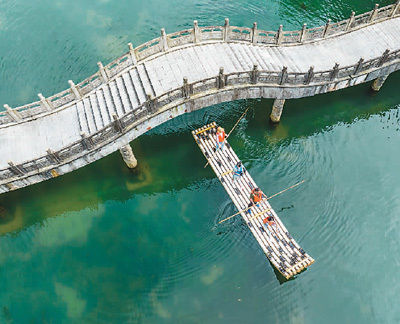
In midsummer, tourists experience the bamboo raft hydrophilic project at the Three Gorges Bamboo Sea Ecological Scenic Spot in Zigui County, Yichang City, Hubei Province. Photo by Wang Gang (People’s Photo)
“Plum, Orchid, Bamboo and Chrysanthemum”. Bamboo has a place among the “Four Gentlemen” of Chinese people’s feelings and aspirations throughout the ages.
In the past few years, I have had many “close contacts” with bamboo and have more feelings for bamboo by taking advantage of the opportunity of engaging in ecological reporting.
Bamboo has always held a pivotal position in the hearts of Chinese people. In 2019, the Beijing World Horticultural Expo was held in Yanqing, Beijing. From the construction of the park site to the end of the event, I witnessed the whole process as a reporter. Among them, the one that left an unforgettable impression on me is the International Bamboo and Rattan Museum in the park.
I still remember the first time I saw the bamboo and rattan pavilion. From a distance, the green space in the garden spreads along the arches to the roof. The architecture, bamboo structure and bamboo landscape are integrated together. Therefore, it has the reputation of “eyes of bamboo”. The four characters of “Green Bamboo Spirit” hanging high above the pavilion door tell the story of bamboo. Before entering the pavilion, the audience can appreciate the spirit of bamboo.
The bamboo is beautiful because of the garden, and the garden is beautiful because of the bamboo. The whole bamboo and rattan pavilion is made of more than 5,000 bamboos, and the main body is also supported by complete bamboos. It is not only very environmentally friendly and practical, but also unique. The overall design of the Bamboo and Rattan Pavilion not only fully reflects the biological characteristics of bamboo’s great toughness, but also vividly shows the indomitable spirit of bamboo “fixing the green hills and not letting go”. The exhibition hall also combines bamboo with Chinese culture, integrating the Meishan Mountain Slope culture, bamboo weaving culture and landscape culture. deeply attracted.
Why is bamboo so popular? This question has always been on my mind. With the deepening of my relationship with bamboo, I also gradually discovered that bamboo is not only an ordinary plant, but also a carrier for people to walk into and embrace nature. Bamboo also provides people with bamboo shoots for survival. Not only that, bamboo’s tenacious vitality and other characteristics also provide people with a lot of spiritual strength and sustenance. This is especially true when I walked to Jinggang Mountain.
“There are five hundred miles of forests and seas in Jinggang Mountain, and the most memorable thing is bamboo.” With the impression of Jinggang Mountain written by Yuan Ying, a reporter from People’s Daily, I set foot on this red hot land with awe. Moso bamboos all over the mountains and plains decorate the majestic Jinggang Mountains. The verdant vitality radiates from the body of each bamboo and overflows from this mountain. As Yuan Ying said: “The older generation of proletarian revolutionaries used the poles made of bamboo from Jinggangshan to carry the heavy burden of the fate of the whole Chinese people from Jinggangshan to Beijing. ”
The wheels of the era are rolling forward. Now, on the road of green development in China and on the journey to achieve carbon neutrality, Bamboo has a new mission.
The existing bamboo forest area in China is very large. Bamboo growing in the ground can absorb a large amount of carbon dioxide every year without any need for us to do anything. Such a bamboo forest has a considerable carbon sink. The ecological value of bamboo is far more than that. Bamboo products can be degraded and can replace many of our existing plastic products, which is very friendly to the environment. Bamboo can also maintain water and soil and build an ecological barrier. In the past two years, in some areas Bamboo is also seen in the restoration of abandoned mines, decorating the previously polluted and ruined places into beautiful parks that are livable and travelable.
With the deepening of the understanding of bamboo, the development of China’s bamboo industry has also entered the fast lane. Walking into the conference room of the International Bamboo and Rattan Center, there are all bamboo decorations and supplies, from bamboo tables to bamboo chairs, to the paper made of bamboo placed on the table. Bamboo products have appeared more and more in front of the public, not only making “a bamboo rich for a party”, but also creating a low-carbon and comfortable living environment for people, and integrating bamboo culture into these bamboo products, which are continuously passed down. .
Bamboo contains rich wealth. To do a good job in this article, the key point is to find a balance between its ecological value and economic value, protect it in development, and develop in protection. In this regard, China is working hard and moving forward step by step.
Outside the International Bamboo and Rattan Building in Beijing, there are lush green bamboos. I can’t help but think of the “green bamboo spirit” above the International Bamboo and Rattan Pavilion, and I can’t help feeling: this is very Chinese.